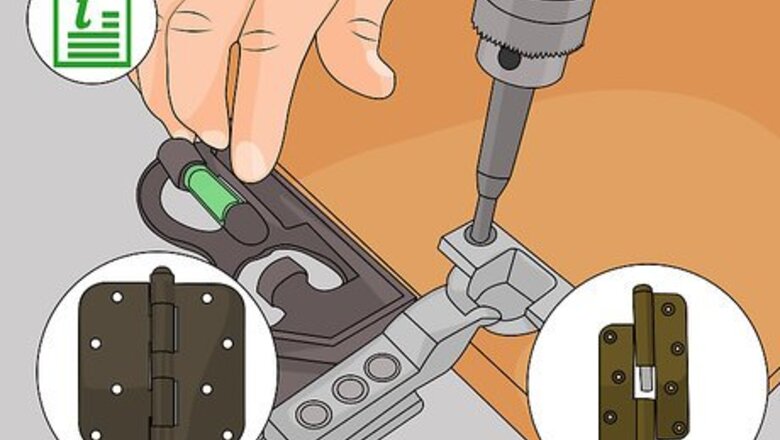
views
Attaching the Hinges
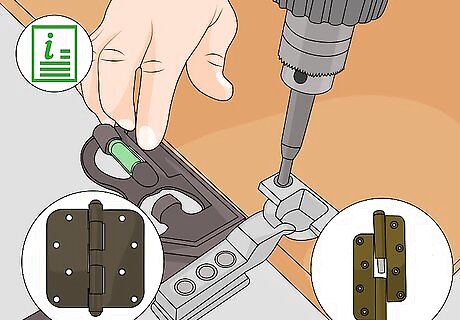
Install the hinges. If you took the hinges off of the door at the start, then you should be able to find the original screw holes. Line the hinges up with those holes and use a hand drive screwdriver to attach them. New doors may or may not have pre-drilled holes for the hinges, so install them 1 ⁄2–2 in (3.8–5.1 cm) from the top and the bottom of the door to ensure they support the door properly. When working with new doors that have never had hinges attached, carefully use a power drill to drill holes for the screws. Make the holes very shallow so you don't drill through the front of the door. Look for a mark of some kind, or read the instructions that came with the cabinets, to determine where the hinges need to go. If you are working with hinges that stay together as one piece, attach them to the door before you attach them to the cabinet. Some hinges will come into two pieces and you'll attach one to the door and one to the cabinet itself.
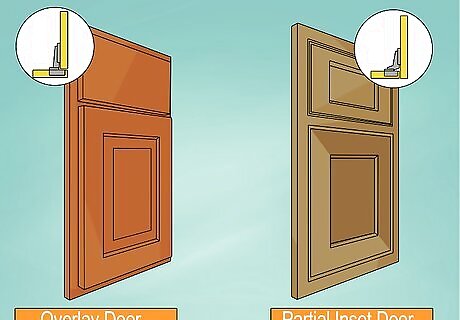
Determine how the door fits against the cabinet. There are at least a few types of cabinet doors, which include overlay doors and partial inset doors. Most doors should overlap the opening by ⁄4 inch (1.9 cm), but the type of door and the type of hinges determines the best way to attach it. If the inside of the door is flat, it is probably an overlay door. If there is a ridge on the inside of the door that would rest inside the cabinet, it is a partial inset door. You can hold the door up against the cabinet to see how it fits. For a partial inset door, move it around to see it if fits tightly in the cabinet opening or if there is room to move it around. This will affect how you position it when you hang it. The type of door you have will determine where the hinges go, to an extent. Some hinges will attach to the face of the cabinet, while others will attach inside the cabinet.
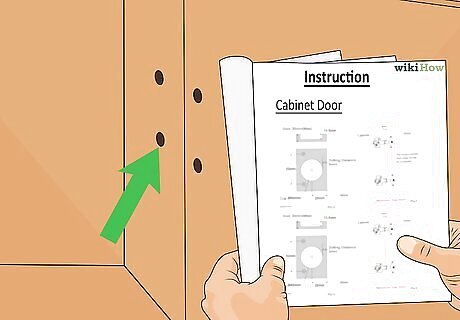
Look for pre-drilled holes in the cabinet. This will help you determine where the hinges attach to the cabinet. If you find holes on the outside or on the inside, that will tell you where the hinges go. If you don't find holes, it's good to consult the instructions if you have them. You may need to drill holes. If you can't find holes anywhere, and you don't have instructions, you'll have to do a little bit of guesswork to determine exactly where the hinges attach. With doors that inset, there is a pretty small margin of error for where you could place the hinges. With overlay doors, your goal is to center the door on the cabinet opening.
Installing the Door
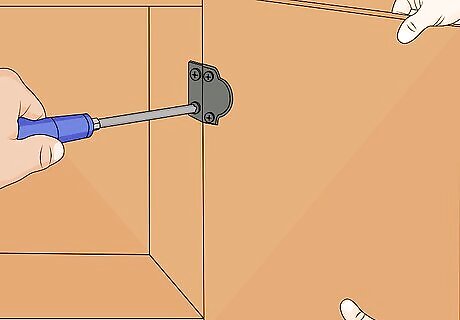
Affix the hinges to the cabinet using a screwdriver. Have someone help you hang the door. If you attach the hinges to the inside of the cabinet, the door will have to be open, so having someone hold it while you insert the screws will help a lot. This is the part where you have to move the door and use your own judgment to align the door straight. Using a small level can help you align the door. It can be helpful to put 1 screw in each hinge and see if the door hangs straight and swings open smoothly. If not, you can remove the screw from one of the hinges, adjust the door slightly, and then replace the screw. When you feel that the door is aligned, insert the rest of the screws into the hinges. Test the door by opening and closing it a few times to see if it moves smoothly.
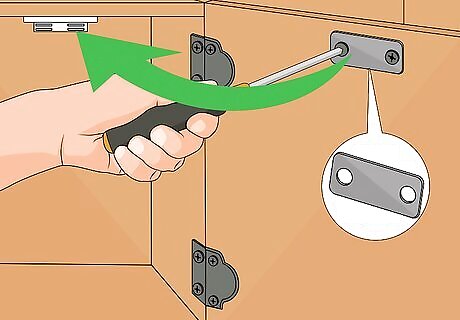
Install a latch. Some cabinets include a latch which keeps the cabinet door shut. This might be a magnetic piece, a roller, or some other type of latch. These are usually attached to the top corner of the door on the opposite side from the hinges. The second part of the latch should be attached to the corresponding spot on the cabinet. This is an optional step because not all cabinets need a latch to stay closed. Even if your cabinets did not come with latches, you can buy some at a hardware store. The holes on the latch pieces where the screws go are often slotted so you can move the screws around as needed. You have the ability to adjust the placement so the latch pieces connect.

Install the handles or knobs using a screwdriver. Some cabinets do not have knobs. The type of handle may determine how you attach it to the door. For upper cabinets, be sure to attach the handle near the bottom of the door. For lower cabinets, the handle should go near the top. Cabinets which feature a handle or knob should have pre-drilled holes which show you where the handle goes. You'll most likely attach the screws on the inside of the door. Use a laser level to make a straight line across the cabinets as a guide for where to drill the holes for your handles.
Aligning the Other Doors
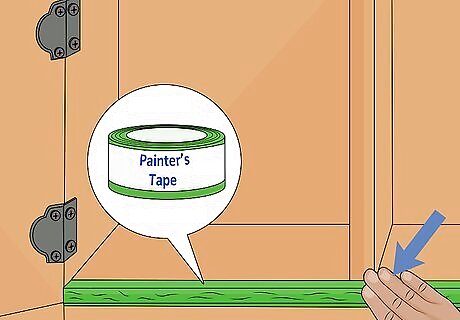
Make a guideline with painter's tape. Open the door that you already hung up. Stretch a piece of tape from the hinged corner of the door across the lower front edge of the rest of the cabinets. You want roughly half of the tape to be covered by the door and half of the tape to be visible. Make this tape line as level as you can. You can use a level to guide as you stretch it out.

Use a level to mark a line for the second cabinet door. Holding the level against the bottom of the first cabinet door, draw a line under the opening for the second door. This line will give you the proper angle to match the second door up to the first door.
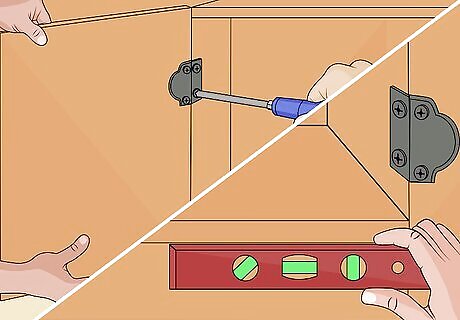
Hang the second door. Follow all of the steps from the previous section to hang the second door. Align the bottom of the door with the mark you made along the tape guideline. Once the door is up, place the level along the bottom of both doors to ensure they are aligned.
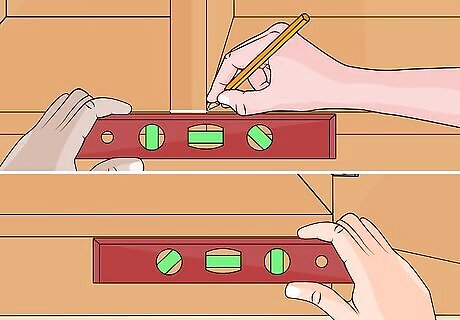
Repeat this process for the remaining doors. As you move down the line of cabinets, you can draw a level guideline for each cabinet door. You can also check to make sure that each door you hang stays level with the one before it.
Sanding and Painting the Doors
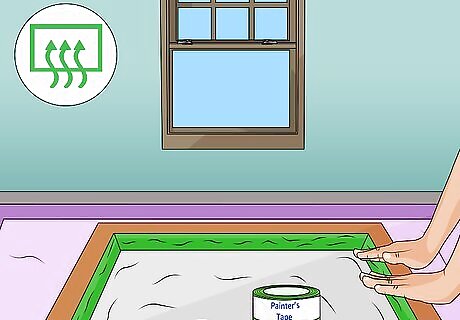
Choose a work area with plenty of ventilation. Use drop cloths to reduce the mess. If the weather is nice and warm, you can work outside, but if you work inside it is best to cover things well. If you are doing a lot of doors, you may want to do a few at a time to reduce the clutter. If you have doors containing glass, it's a good idea to tape some paper over the glass to protect it from stains. You'll also want to be careful as you move these doors around so you don't break the glass. If your doors have a divider, you can usually fit a piece of paper between the divider and glass so you can easily paint the entire area.
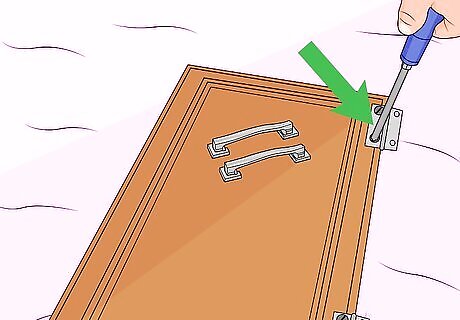
Remove the hardware. You will be sanding and painting the doors, and this is much easier to do with only the wooden door. Use a screwdriver, electric or hand drive, and take off all the hinges and knobs or handles. Set these aside for when you put them back on. These are most likely interchangeable between doors, but you can mark them in some way if you want to put them back with the same door they were on.
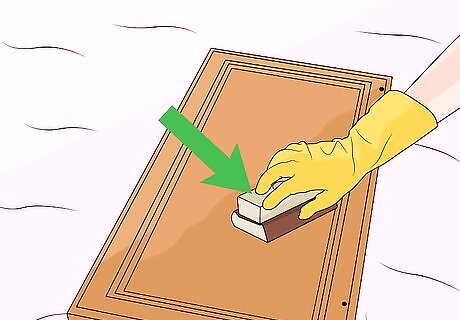
Sand the outside of your cabinets. Whenever you refinish wood, it is a good idea to give it a thorough sanding first. You can use a few coarseness levels to get the job done. Using a sanding block for all of the flat areas will save you time. Clean the doors with denatured alcohol before you prime them. Sanding serves two main purposes: it removes old paint or stain and roughs the surface up for new paint or stain. Don't go overboard and take a half inch off the doors, but make sure that all of the old paint or stain is gone. When you finish, the doors should have a smooth, dull look to them.
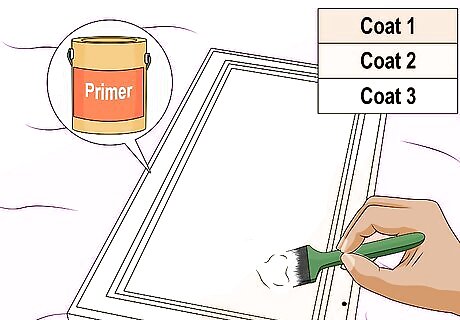
Prime and paint or stain the doors. If you want to paint your cabinet doors, it is always good to give them a coat of primer. It helps the paint stick. If you stain them, you don't need any other product, but you may want to put two or three coats on for a full coverage. Be sure to cover any surface that you paint over. Allow the cabinet doors to dry before you hang them up. If you painted the doors, you may want to use a nail or other thin instrument to gently poke all of the screw holes to clean the paint out so it doesn't dry and clog the holes.




















Comments
0 comment